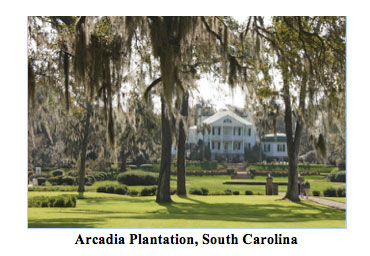Life and Island Times: Vanished World
After Ricetown, their route took the bikers further off the beaten path on narrow two-lane roads connecting various settlements in the coastal low country. The roads wound through seemingly endless green hills, past occasional
working farms and several stone churches perched on small rises.
Their path became increasingly tree-lined and woodsy as they rode north.
By late that afternoon they were cruising along a river, helping themselves to weather that was especially dry and sunny for the season. Steve was at the group’s helm, when they skirted a loose group of raggedly farm vehicles and
open bed trucks with field hands, obviously en route to or from that day’s labor fields somewhere along the banks of this unnamed dark tea brown river.
Once beyond them, they saw the river’s swampy banks were lined with wide-hipped cypress and tupelo trees draped with Spanish moss. Cormorants preened on dead branches, and the occasional osprey circled low over the
shallows.
They were deep in the pre-Civil War rice plantation region of the south.
The area was once the western world’s #1 producer of rice that was coveted in 18th and 19th century Europe. The trees reemergence was a signal that this entire expansive area was coming full circle — from cypress swamps to rice
fields and back again.
In a remarkable feat of human labor and engineering, African slaves cut thousands of acres of trees, dug stumps and drained the land by building a series of levees, canals and flood-gates.
Although the wooden sluices that lined the banks are now rotted and almost completely swallowed by marsh grass, they provided glimpses of what was a brief mastery by man of the landscape and his fellow man.
There were what looked to be the ruins of very old plantation houses. One would have thought that they could estimate these decaying dwellings’ age by the gargantuan live oak trees that flanked the crumbling brick foundations.
Some of these trees were so big their limbs rested on rusting cast iron braces. Augustus was adamant that the trees were older.
”No one can agree. Some say 200 years, others 800.”
As the road veered away from the river, they came upon another long ago rice farm that was apparently totally restored by someone who had more money than God like a Vanderbilt or a Rockefeller.
They pulled off to investigate. Not directly abutting the river, this mammoth, green-roofed plantation house, towering like a Dixie Xanadu above well-manicured gardens sat on high ground less than a quarter of a mile off of the
river. Behind the main house were the remnants of long, narrow canal that led to an old rotting wooden gate at the canal’s mouth to the river.
These plantations, both decrepit and restored, were looking glass views into a vanished world. The bikers felt they were a million miles and 200 years away from where they started that day.

So the riders were more than mildly surprised when after only several hundred more yards further on down the two lane road, they pulled up to a stop sign at the intersecting US 17. They were back in the civilized world and were
quickly swallowed by speedy beach-minded traffic.
Copyright © 2017 From My Isle Seat
www.vicsocotra.com
